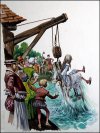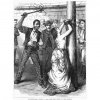A lot of us here have something in common with many people in the ancient world - we love to see a good punishment. From a whipping or pelting someone in the stocks to hangings or, you know, crucifixion, it's good to see harsh justice being done to the deserving, right? (And if the deserving is a pretty girl, well, that makes a change from the usual nee'r-do-wells.)
However, for the above to be civilized justice, there must be judgement first - and before that, accusation. In a world before policing as we know it today emerged, what road brought criminals (true or purported) from living fancy free to standing before a judge? Who captured them? Where were they held, and under what conditions? And how was the trial, if any put together - getting the right people in court at the right time and so on? Did punishment follow directly after conviction, and if not, what came between?
Feel free to present answers from any historical era, or your own ideas for how such might be handled in a similar setting.
However, for the above to be civilized justice, there must be judgement first - and before that, accusation. In a world before policing as we know it today emerged, what road brought criminals (true or purported) from living fancy free to standing before a judge? Who captured them? Where were they held, and under what conditions? And how was the trial, if any put together - getting the right people in court at the right time and so on? Did punishment follow directly after conviction, and if not, what came between?
Feel free to present answers from any historical era, or your own ideas for how such might be handled in a similar setting.
















